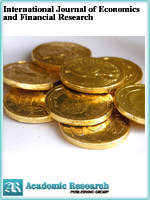International Journal of Economics and Financial Research
Online ISSN: 2411-9407
Print ISSN: 2413-8533
Print ISSN: 2413-8533
Quarterly Published (4 Issues Per Year)

Archives
Volume 6 Number 4 April 2020
Risk Velocity and Financial Markets Performance: Measuring the Early Effect of COVID-19 Pandemic on Major Stock Markets Performance
Authors: Musaed S. AlAli
Pages: 76-81
DOI: doi.org/10.32861/ijefr.64.76.81
Abstract
Capital is coward, money tend to flee the markets during crises periods. In just few days after declaring Coronavirus as a pandemic by the World Health Organization (WHO), major stock markets lost more than 15% of their market capitalization. This study aims to examine the velocity of Coronavirus pandemic effect on major stock markets during the early stages of the pandemic. The study also examines whether or not there was any difference before and after the first confirmed Coronavirus case reported. Using the data on eleven major stock markets, results from this study shows that, out of the eleven markets under study, six markets showed no difference in mean return 30 trading days before and after reporting the first Coronavirus case in these countries. The results also showed that WHO announcement had a more impact on the stock markets performance than the announcements of local health authorities’ announcements. One interesting finding in this research is that there was an inverse relation between the distance of the stock market from Wuhan and the financial performance of that market.
Can Monetary Policy Prevent Financial Crises?
Authors: Dr. Ioannis N. Kallianiotis
Pages: 51-75
DOI: doi.org/10.32861/ijefr.64.51.75
Abstract
Monetary policy is an important public policy, but it is not the only one to stabilize our economy and reduce its business cycles. The leading central bank, the Federal Reserve of the U.S., has introduced, after the 2008 global financial crisis, new instruments and unusual facilities to implement its new innovative monetary policy. The financial world and mostly the social scientists watch as the Federal Open Market Committee (FOMC) decides on a target interest rate in the federal funds market for the next period. The framework that the FOMC uses to implement monetary policy has changed over the last twelve years and continues to evolve today. Here, we try to evaluate the new instruments and their “effectiveness”. Before the 2008 financial crisis, policymakers used one set of traditional instruments (tools) to achieve the target rate. However, several policy interventions, introduced soon after the crisis, drastically altered the landscape of the federal funds market and the traditional economic theory. This new and uncertain environment, with enormous reserves and even interest on reserves, necessitated a new set of instruments by the Fed for its monetary policy implementation. Lately, after seven years of zero interest rate, the FOMC began in December 2015 to increase the target rate and then, went back again to a lower one, but many questions arise. How did they evaluate the effectiveness of these new instruments? Is the current federal funds rate the appropriate one for our economic wellbeing? How efficient was so far this ZIR monetary policy after the latest global financial crisis? Why the Fed put all these burdens of its ‘innovated” new monetary policy to the poor taxpayers (bail out) and to the risk-averse depositors (bail in)? Is it possible for the Fed’s policy to prevent the future financial crises? The federal funds rate was very low and affected negatively the financial markets (bubbles were growing), the real rates of interest (it is negative for twelve years), and the deposit rates (they are closed to zero for twelve years). The redistribution of wealth of depositors and taxpayers continues, which means the true economic welfare is falling and a new global recession was in preparation, if the current unfair easy money policy will persist, ignoring the necessity of a prevention of financial crises. Then, it came as an unexpected plague the coronavirus pandemic, following with a new but, the worse in economic history global crisis (chaos).



